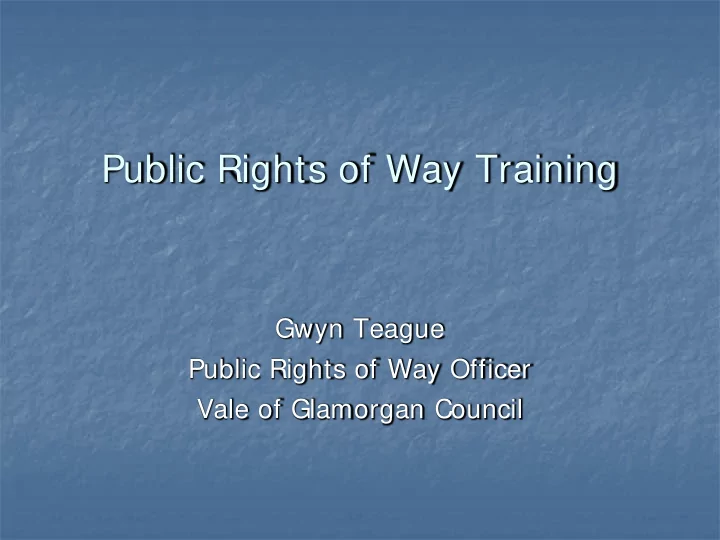

Public Rights of Way Training Gwyn Teague Public Rights of Way Officer Vale of Glamorgan Council
Background Definitive maps are legal records of public rights Footpaths Bridleways Restricted Byways Byways Open to All Traffic
Maintaining & Protecting Highway Authority Responsibilities Keep the surface of public rights of way which are maintained at public expense in a fit state for public use Make sure obstructions are removed Maintain some bridges over natural watercourses, including farm ditches
Maintaining & Protecting Highway Authority Responsibilities Provide at least a 25% contribution to landowners’ costs for replacing and maintaining structures for the control of animals, eg gates or stiles, on completion of the work to a standard the highway authority is satisfied with Make sure there are no notices that prevent or discourage the use of a public right of way Add signs where a public right of way leaves metalled roads
Maintaining & Protecting Highway Authority Responsibilities Make sure the public’s rights to use a public right of way are protected Make sure landowners carry out their duties, and take action if they don’t
Maintaining & Protecting Landowner Responsibilities Avoid putting obstructions on or across the route, such as permanent or temporary fences, walls, hedgerows, padlocked gates or barbed wire Make sure vegetation does not encroach onto the route from the sides or above, bearing in mind the different clearances needed for users of different types of route, for example by horse riders
Structures & Furniture Stiles & gate on public rights of way are usually the landowner’s responsibility Can claim 25% towards work as minimum Often authority carries out work in full. Landowners should seek the local highway authority’s permission before installing any new structure on a public right of way. Unauthorised structures are obstructions and may be removed by the highway authority at the landowner’s expense.
Structures & Furniture When agreeing structures the authority will consider the needs of people with mobility problems and other disabilities by applying least restrictive access principles. This will include consideration of the number of structures and keeping to a minimum in so far as possible Agreeing the most accessible type of structure appropriate to the location, preferring a gap or gate rather than a stile. Detailing each type of structure in legal documentation by reference to British Standards.
Livestock Bulls of recognised dairy breeds (Ayrshire, British Friesian, British Holstein, Dairy Shorthorn, Guernsey, Jersey and Kerry) that are over the age of 10 months are banned by law from fields containing a public right of way. Bulls over 10 months of any other breed must be accompanied by cows or heifers when in fields with public access. Warning notices relating to a bull should only be displayed when it is actually present in a field.
Livestock Horses may be kept loose in fields crossed by public rights of way, as long as they are not known to be dangerous. Landowners can be prosecuted by HSE if they keep potentially dangerous animal on land crossed by a public right of way
Cultivation Land occupiers must not cultivate (eg plough) footpaths or bridleways that follow a field edge. The minimum width they need to keep undisturbed is: 1.5 metres for a field edge footpath 3 metres for a field edge bridleway Occupiers should avoid cultivating a cross-field footpath or bridleway where possible. Where unavoidable the footpath or bridleway should: remain apparent on the ground to at least the minimum width of 1 metre for a footpath or 2 metres for a bridleway, and not be obstructed by crops be restored to at least the minimum width so that it’s reasonably convenient to use within: 14 days of first being cultivated for that crop 24 hours of any subsequent cultivation, unless a longer period has been agreed in advance in writing by the highway authority
Questions Any questions Practical Work
Recommend
More recommend